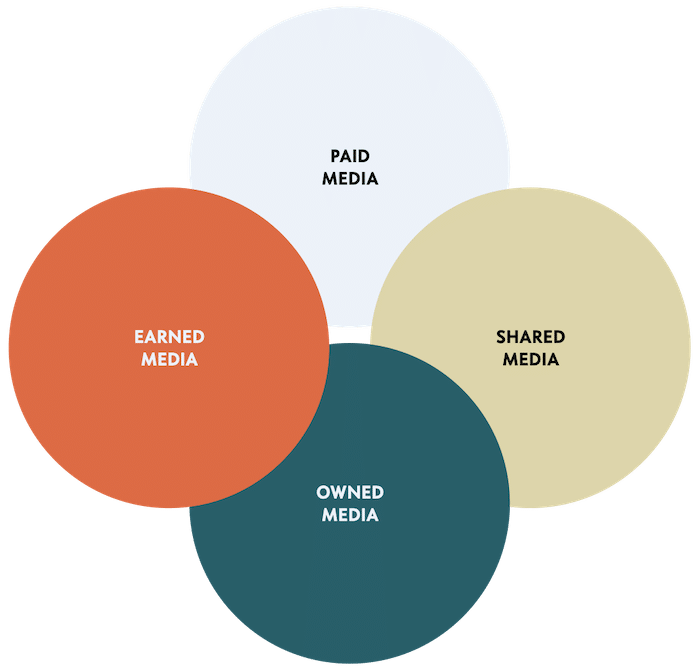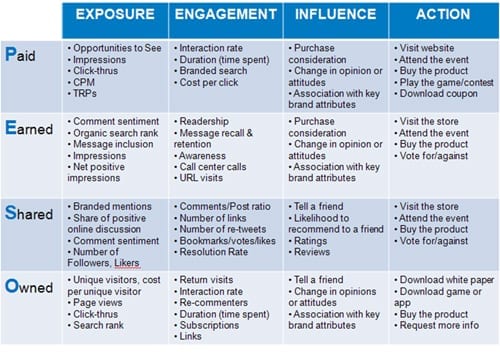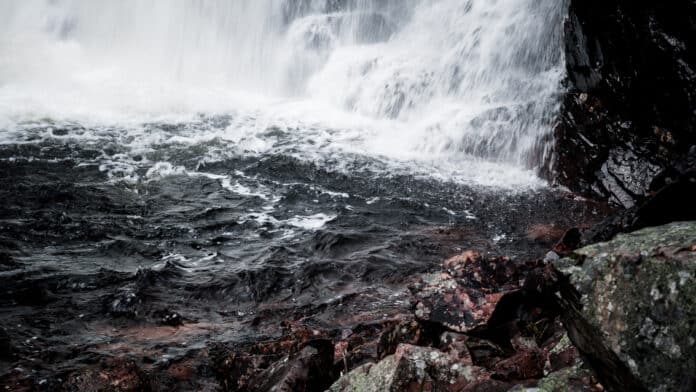The PESO model is helpful in public relations.
The PESO model is used to classify different types of media: paid, earned, and shared media. The model has emerged as an invaluable tool for navigating the complexities of modern public relations.
This contemporary approach to PR affords organisations a more comprehensive and strategic perspective on their communications efforts, responding adeptly to the exponential rise in digital channels and audience segmentation.
Here we go:
The PESO Model
The PESO Model
I often use the PESO model to underscore the critical differences between marketing (paid media) and public relations (earned, shared, and owned media).

The PESO model divides the media landscape into four different media channel types:
Don Bartholomew, vice president of digital research at Fleishman Hillard, presented a version of the PESO model in 2010. According to PR blogger and PR measurement expert Heather Yaxley, his 2010 article is likely to be the earliest mention of the model:

In 2013, PR blogger Gini Dietrich popularised the PESO model on her blog — and later trademarked! — her heavily promoted and widely spread infographic.
“In June 2013, Gini Dietrich presented the first iteration of the PESO model you may recognise in a blog post: The Four Different Types of Media. It was followed in August by the post Mobile Marketing: Use the Four Media Types in Promotion, where she talked about integrating paid, earned, owned, and shared.”
Source: PRConversations.com 1Yaxley, H. (2020, June 28). Tracing the measurement origins of PESO. PRConversations.com. https://www.prconversations.com/tracing-the-measurement-origins-of-peso/
“It is also worth pointing out this 2010 McKinsey Quarterly article by David Edelman and Britan Salsburg that includes sold and hijacked media alongside what used to be called POEM (paid, owned and earned media). Both of these concepts still have value even though their execution has changed in the past decade.“
Source: PRConversations.com 2Yaxley, H. (2020, June 28). Tracing the measurement origins of PESO. PRConversations.com. https://www.prconversations.com/tracing-the-measurement-origins-of-peso/
Learn more: The PESO Model: Paid, Earned, Shared, and Owned Media
Different Types of Media in PR
Paid Media
Paid media is somewhat foreign to public relations, encompassing advertisements, sponsored content, and other forms of purchased exposure. However, the PESO model underscores its utility not as a standalone strategy but as one component in a much larger orchestra of tactics.
By dovetailing paid efforts with other media types, organisations can extend the reach of their messaging, complementing traditional advertising with the authenticity and engagement offered by earned, shared, and owned media.
Earned Media
Earned media refers to publicity gained through methods other than paid advertising. It includes news features, reviews, and any other form of coverage that an organisation doesn’t directly control.
Earned media is often seen as a wild card due to its unpredictability. However, coherent and integrated communication activities can help shape the narrative and create the conditions for positive coverage, allowing organisations to take advantage of the credibility earned media provides.
Shared Media
Shared media represents a newer but no less significant sphere of PR. Encompassing social media platforms and other user-generated content, shared media fosters dialogue and engagement. The PESO model acknowledges its growing influence, and its intersection with other media types is crucial.
Organisations can boost engagement, feedback, and virality by sharing owned content or promoting paid media on social platforms, turning audiences from passive recipients into active participants.
Owned Media
Owned media refers to the channels controlled by the organisation, such as websites, blogs, newsletters, and more.
While owned media provides unparalleled control over the message, the PESO model recognises that it’s most effective when strategically integrated with the other three types. For instance, owned content can extend the life of earned media coverage or serve as a launchpad for paid and shared media campaigns.
A Great Model — But Not Perfect
The PESO model underscores the interconnected nature of modern public relations. Rather than viewing each media type in isolation, it encourages a holistic approach that aligns and integrates various media strategies.
I prefer to use the model to underscore the critical differences between marketing (paid media) and public relations (earned, shared, and owned media). Others prefer to use the model to showcase how public relations could venture into paid media channels.
“If a young man tells his date how handsome, smart and successful he is — that’s advertising. If the young man tells his date she’s intelligent, looks lovely, and is a great conversationalist, he’s saying the right things to the right person and that’s marketing. If someone else tells the young woman how handsome, smart and successful her date is — that’s PR.”
— S. H. Simmons
In a time where the lines between public relations, marketing, and advertising continue to blur, the PESO model offers a versatile and adaptable framework that mirrors the complexity of the modern media landscape.
In short: The PESO model is imperfect but useful when analysing the modern media landscape.

THANKS FOR READING.
Need PR help? Hire me here.

PR Resource: The PESO Paradox
The PESO Paradox
According to the PESO model, there are four types of media channels.

These four types of media channels are:
How do you categorise these four types of media channels?
Categorisation = Corporate Function
A popular approach is to divide them based on corporate function:
Marketing (Corporate Function)
Communications (Corporate Function)
Categorisation = Corporate Control
Another approach is to divide the PESO media channels based on corporate control:
Total (Corporate Control)
Partial (Corporate Control)
Indirect (Corporate Control)
Categorisation = Corporate Value
A third but central approach to the PESO media channels is based on conversion/monetisation strategies:
Awareness (Corporate Value)
Transactional (Corporate Value)
The various above perspectives force organisations to face problematic paradoxes:
The PESO paradox = paid, earned, shared, and owned media channels can be grouped in different ways that are equally and simultaneously true but also strategically conflicting, which creates a measurement problem (comparative validity) for organisations.
How do you set up a reliable process to accurately determine how to distribute your media channel investments?
Typical PESO Considerations
Here are some typical considerations of the PESO paradox:
Please note: The PESO model has “fuzzy edges” due to various hybrid media forms. For example, you can run campaign banner ads or social forums on your website or add advertising spots within editorial social media content.
Learn more: The PESO Paradox
Annotations
| 1, 2 | Yaxley, H. (2020, June 28). Tracing the measurement origins of PESO. PRConversations.com. https://www.prconversations.com/tracing-the-measurement-origins-of-peso/ |
|---|


